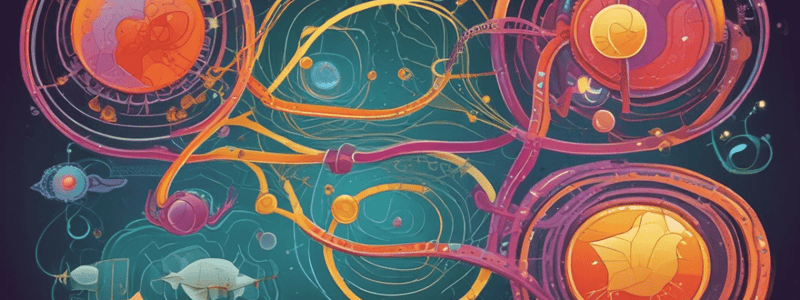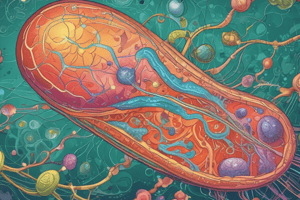Podcast
Questions and Answers
What is the primary site of oxygen utilization in aerobic tissues?
What is the primary site of oxygen utilization in aerobic tissues?
- In the TCA cycle
- In the mitochondrial intermembrane space
- In the electron transport chain (correct)
- During the oxidation of NADH and FADH2
What is the number of reactions that produce NADH + H+ from NAD+ in the TCA cycle?
What is the number of reactions that produce NADH + H+ from NAD+ in the TCA cycle?
- Two
- Three
- One (correct)
- Five
Where does the oxidation of NADH and FADH2 produced in the TCA cycle occur?
Where does the oxidation of NADH and FADH2 produced in the TCA cycle occur?
- On the inner mitochondrial membrane (correct)
- In the cytosol
- In the mitochondrial matrix
- In the nucleus
What is the characteristic of the electron transport chain?
What is the characteristic of the electron transport chain?
What would be the effect of making the inner mitochondrial membrane freely permeable to protons?
What would be the effect of making the inner mitochondrial membrane freely permeable to protons?
Which of the following would occur if the electron transport chain were inhibited?
Which of the following would occur if the electron transport chain were inhibited?
What is the product of the reaction catalysed by pyruvate dehydrogenase?
What is the product of the reaction catalysed by pyruvate dehydrogenase?
What is the central role of acetyl-CoA in metabolism?
What is the central role of acetyl-CoA in metabolism?
What is the purpose of the dehydrogenase enzymes in the TCA cycle?
What is the purpose of the dehydrogenase enzymes in the TCA cycle?
What is the metabolic importance of oxaloacetate?
What is the metabolic importance of oxaloacetate?
What is the role of the TCA cycle in biosynthesis?
What is the role of the TCA cycle in biosynthesis?
What is the result of the metabolic events of the TCA cycle?
What is the result of the metabolic events of the TCA cycle?
What is another name for the pathway that involves the oxidation of acetyl CoA to CO2 and water?
What is another name for the pathway that involves the oxidation of acetyl CoA to CO2 and water?
Where does the TCA cycle take place?
Where does the TCA cycle take place?
What is the energy yield of the TCA cycle?
What is the energy yield of the TCA cycle?
What is the function of citrate synthase?
What is the function of citrate synthase?
What is the byproduct of the conversion of α-ketoglutarate to succinyl-CoA?
What is the byproduct of the conversion of α-ketoglutarate to succinyl-CoA?
Which of the following is NOT a tissue where the TCA cycle takes place?
Which of the following is NOT a tissue where the TCA cycle takes place?
What is the purpose of the link reaction?
What is the purpose of the link reaction?
Which enzyme is responsible for the conversion of fumarate to malate?
Which enzyme is responsible for the conversion of fumarate to malate?
What is the net result of the re-oxidation of NADH and FADH2 via the electron transport chain?
What is the net result of the re-oxidation of NADH and FADH2 via the electron transport chain?
Which of the following is an irreversible step in the TCA cycle?
Which of the following is an irreversible step in the TCA cycle?
Which of the following electron carriers is responsible for accepting electrons from NADH in the electron transport chain?
Which of the following electron carriers is responsible for accepting electrons from NADH in the electron transport chain?
What is the primary function of the electron transport chain in oxidative phosphorylation?
What is the primary function of the electron transport chain in oxidative phosphorylation?
How does the rate of electron transport affect the proton gradient and ATP synthesis?
How does the rate of electron transport affect the proton gradient and ATP synthesis?
What is the effect of uncouplers on the electron transport chain and ATP synthesis?
What is the effect of uncouplers on the electron transport chain and ATP synthesis?
Which of the following is a characteristic of the electron transport chain in the mitochondrial inner membrane?
Which of the following is a characteristic of the electron transport chain in the mitochondrial inner membrane?
What is the role of the F0, F1-ATP synthase in oxidative phosphorylation?
What is the role of the F0, F1-ATP synthase in oxidative phosphorylation?
How does the level of ATP affect the rate of electron transport?
How does the level of ATP affect the rate of electron transport?
What is the effect of inhibitors on the electron transport chain and ATP synthesis?
What is the effect of inhibitors on the electron transport chain and ATP synthesis?
What is the role of the proton gradient in oxidative phosphorylation?
What is the role of the proton gradient in oxidative phosphorylation?
What is the net ATP yield from the complete oxidation of one molecule of glucose?
What is the net ATP yield from the complete oxidation of one molecule of glucose?
Study Notes
Aerobic Metabolism: The TCA Cycle and Oxidative Phosphorylation
- In aerobic tissues, O2 utilization results from its reduction to H2O by cytochrome oxidase.
- The TCA cycle (also known as Krebs cycle, Citric acid cycle, or Tricarboxylic acid cycle) is a common terminal pathway for the catabolism of sugars, fats, and amino acids.
- The TCA cycle occurs in the mitochondrial matrix of all tissues with mitochondria, except for red blood cells and white muscle fibers.
TCA Cycle Reactions
- The TCA cycle is a series of 8 reactions that convert acetyl-CoA into 2 molecules of CO2.
- The cycle produces NADH and FADH2, which are used to generate ATP in the Electron Transport Chain.
- The TCA cycle also produces GTP, which is used to generate ATP.
- The reactions of the TCA cycle are:
- Condensation reaction: Citrate synthase catalyzes the formation of citrate from oxaloacetate and acetyl-CoA.
- Isomerisation: Aconitase catalyzes the conversion of citrate to isocitrate.
- First loss of CO2: Isocitrate dehydrogenase catalyzes the conversion of isocitrate to α-ketoglutarate.
- Second loss of CO2: α-Ketoglutarate dehydrogenase catalyzes the conversion of α-ketoglutarate to succinyl-CoA.
- Trapping thioester bond energy as GTP: Succinyl-CoA synthetase catalyzes the conversion of succinyl-CoA to succinate and GTP.
- Conversion of succinate to fumarate: Succinate dehydrogenase catalyzes the conversion of succinate to fumarate.
- Conversion of fumarate to malate: Fumarase catalyzes the conversion of fumarate to malate.
- Conversion of malate to oxaloacetate: Malate dehydrogenase catalyzes the conversion of malate to oxaloacetate.
Generation of ATP
- The re-oxidation of NADH to NAD and FADH2 to FAD via the Electron Transport Chain results in the synthesis of ATP from ADP and Pi (Oxidative Phosphorylation).
- The energy yields of the TCA cycle are:
- 3 enzyme reactions produce NADH and H+, yielding 3 x 2.5 ATP = 7.5 ATP.
- 1 enzyme reaction produces FADH2, yielding 1 x 1.5 ATP = 1.5 ATP.
- 1 enzyme reaction produces GTP, yielding 1 x 2 ATP = 2 ATP.
- Total ATP yield: 12 ATP (old numbers) or 10 ATP (new numbers).
Irreversibility of Key Stages
- Three enzyme steps are highly exergonic and irreversible:
- Citrate synthase
- Isocitrate dehydrogenase
- α-Ketoglutarate dehydrogenase### Chemical Nature and Sequential Arrangement of Electron Carriers
- Electron carriers in the mitochondrial inner membrane are organized in complexes that conserve energy from the reoxidation of NADH and FADH2 by pumping protons across the membrane.
- The energy from the proton gradient is used for the synthesis of ATP from ADP by the F0, F1-ATP synthase.
Electron Transport Chain
- The electron transport chain is a process for the transfer of H atoms to oxygen.
- It takes place in the mitochondria and occurs in most tissues and cell types, except for red blood cells.
- The function of the electron transport chain is to trap energy and phosphorylate ADP to produce ATP.
- Components of the electron transport chain are "buried" in the inner mitochondrial membrane.
- The electron transport chain involves the stepwise transfer of H atoms to O2, with the participation of electron carriers such as NADH, flavin cofactors, coenzyme Q, iron-sulfur proteins, and cytochrome proteins.
Electron Carriers
- NADH is the reduced form of nicotinamide adenine dinucleotide, with a nicotinamide ring and a ribose molecule.
- The electron transport chain involves the transfer of electrons from NADH to O2, resulting in the formation of water and the release of energy.
Complexes of the Electron Transport Chain
- Complex I: NADH dehydrogenase, also known as NADH:ubiquinone oxidoreductase.
- Complex III: cytochrome b-c1 complex, also known as cytochrome reductase.
- Complex IV: cytochrome c oxidase, also known as cytochrome a3.
- The electron transport chain is organized in these complexes, which work together to pump protons across the membrane and generate a proton gradient.
ATP Synthesis
- The proton gradient is used to drive the synthesis of ATP from ADP by the F0, F1-ATP synthase.
- The ATP synthase is a membrane-associated protein that uses the energy from the proton gradient to drive the phosphorylation of ADP.
Control of Electron Transport
- The rate of electron transport is controlled by the levels of ADP and ATP, a process known as respiratory control or "tightly-coupled" oxidative phosphorylation.
- Increased ADP levels increase the rate of O2 uptake, while increased ATP levels decrease O2 uptake.
Inhibitors and Uncouplers
- Inhibitors of oxidative phosphorylation include CN, rotenone, and CO, which block the electron transport chain.
- Uncouplers of oxidative phosphorylation include dinitrophenol (DNP) and thermogenin protein in brown adipose tissue, which disrupt the proton gradient and prevent ATP synthesis.
ATP Yield
- The ATP yield from the complete oxidation of one molecule of glucose is 32 or 30 ATP, depending on the shuttle used to transfer NADH into the mitochondria.
- The ATP yield from the oxidation of NADH is 2.5 ATP, while the ATP yield from the oxidation of FADH2 is 1.5 ATP.
Studying That Suits You
Use AI to generate personalized quizzes and flashcards to suit your learning preferences.
Description
Test your knowledge on cellular respiration, TCA cycle, and electron transport chain. Answer questions on the primary site of oxygen utilization, NADH production, and the effects of inhibiting the electron transport chain.


